
Johannes Kepler's (1571-1630) was a rather strange figure in the history of astronomy. Kepler was not really an observer, rather he was a mathematician. His analysis of Tycho Brahe's observational data of the position of Mars, lead to one of the most important discoveries in astronomy. Kepler found that the orbit of Mars (as well as all of the planets in the solar system) followed three relations. These relations are now known as Kepler's three laws of planetary motion. When Kepler developed his Laws of planetary motion he did not know the underlying physical reason why the planets behaved in this manner. His laws were purely empirical relationships. We now know that Kepler's laws are the consequence of bodies moving under the influence of gravity. This means that Kepler's laws are universal. They not only describe the motion of the planets, but of satellites, comets, asteroids, stars and even galaxies.
Kepler's laws apply to any object, orbiting another object, under the influence of gravity.
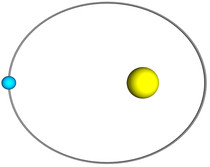
I. The orbit of a planet about the Sun is an ellipse with the Sun at one focus.
The image on the right shows the elliptical orbit of a planet (blue) around the Sun (yellow), with the Sun at one of the foci of the ellipse. Actually, it is the center of mass of the Solar system that is at one focus. The center of mass of our Solar system is near the surface of the Sun, so saying the Sun is at one focus is not to far off. In general, Kepler's first law states that the orbit of one object around another is an ellipse with the center of mass of the system at one focus.
An elliptical orbit is characterized by two parameters (see the figure below). The first parameter is called the semi-major axis and is represented by the letter a. The semi-major axis is a measure of the size of the orbit, the larger the semi-major axis the larger the orbit. For an elliptical orbit, the semi-major axis is also the average distance of the object (planet) from the focus (Sun). I will often refer to the average distance of an orbit. - this is really just the semi-major axis.
The semi-major axis of the Earth's orbit around the Sun is 149,597,887.5 km (about 93 million miles). This distance is called an Astronomical Unit and is represented by AU. This will be the most common unit of distance in this class. The Earth is 1 AU from the Sun. Mars is 1.52 AUs from the Sun, or about 1.5 times farther away.
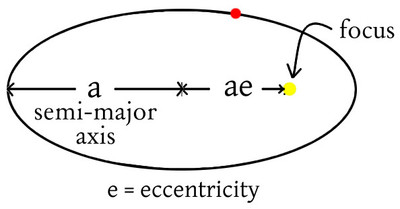
The second parameter that characterizes an elliptical orbit is called the eccentricity and is represented by the letter e. The value for e ranges from 0.0 to 1.0. The eccentricity is a measure of the shape of the orbit. The higher the eccentricity (the closer it is to 1.0) the "flatter" the orbit.
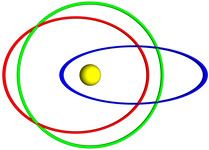
The figure on the left shows three orbits with the same value of a but with different values of e. The green orbit has e = 0.0, the red orbit e = 0.3, and the blue orbit has e = 0.7. As you can see a circular orbit is simply an elliptical orbit with e = 0.0.

In our Solar system the orbits of most the planets are nearly circular. A circle is just a special case on an ellipse. The figure on the right shows the orbits of the 4 inner worlds Mercury, Venus, Earth and Mars. As you can see, their orbits are very close to circular. There are objects in our solar system (i.e. comets) with very elliptical orbits.
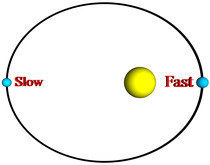
The speed of a planet in orbit around the Sun is not constant. The planet's speed continually varies as it moves along its elliptical orbit. The planet moves fastest when it is closest to the Sun [called perihelion] and slowest when furthest away [called aphelion].
A more precise way of defining the planet's changing speed is to imagine a line connecting the planet with the Sun. Kepler's second law then states:
Kepler's Second Law
II. A line joining a planet and the Sun sweeps out equal areas in equal intervals of time .
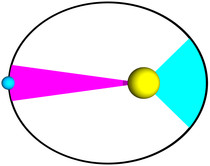
In this figure is takes the same amount of time for the planet to sweep out the blue area as it does to sweep out the pink area. Kepler's second law states then that the area of the blue wedge is the same as the pink wedge. Of course you can take any two equal time intervals (not just around aphelion and perihelion as I have shown here) and the areas swept out will be equal.
In a circular orbit (e = 0.0) the speed of the planet is constant since the distance from the focus is always the same. In a very elliptical orbit (e close to 1.0) the speed of the planets changes a lot. It is very fast close to the focus, and very slow far away.

Not only is the speed of a planet in orbit around the Sun not constant, the times it takes to make one orbit of the Sun (called its Period) depends on the average distance from the Sun to the planet. Planets that are further from the Sun take longer to orbit than planets that are closer to the Sun (i.e. Mars has a period of 1.6 years while the Earth has a period of 1 year).
The relationship between a planet's period and its average distance is given by Kepler's third law:
Kepler's Third Law
III. The squares of the periods of the planets are proportional to the cubes of their semi-major axis (average distance).

What this boils down to is that the larger the semi-major axis of an orbit, the longer it takes the planet to orbit the Sun.

A little more need to be said about the average distance business. The figure on the right shows three orbits. All three of these orbits have the same average distance. However, since a planet moves in an elliptical orbit its distance from the Sun can be constantly changing. This means that even thought two object have the same average distance they may have very different distances at any one particular moment in time. For example, Halley's comet has a period of about 76 years. Kepler's third law would tell us that Halley's comet has an average distance much greater than that of the Earth. However, there is a time in Halley's comet's orbit that brings it closer to the Sun than the Earth.
Kepler's third law is a mathematical relation between a planet's period and its average distance. With a little simple algebra we can determine one of the values if we are given the other. First of all it helps to rearrange the relationship slightly and apply a little cleverness:

Kepler's third law can be rearranged and turned in to an equality as is shown on the left. The Constant is just a number. However, it is important to know that this Constant is the same for anything orbiting the Sun. The value of this Constant depends on the units you use to measure the Period and Average Distance. Here is where the clever part come in:

If you measure the Period in [years] and the Average Distance in astronomical units [AU] [an astronomical unit is defined as the average distance between the Earth and the Sun] then the Constant equals 1. Why is this? Well the Earth has a period of 1 year and an average distance if 1 AU. Stick these numbers into the equation above and the Constant equals 1. Now, since this constant is the same for everything orbiting the Sun, as long as you measure the period in years and the average distance in AUs then the Constant is always 1.
Determine the period of an object that orbits the Sun at an average distance of 4 AU.
Plug the average distance into the equation above, do a little algebra:

And voila! An object with an average distance of 4 AU takes 8 years to go around the Sun. Easy as can be. Of course not all (or many) problems have such nice integer answers, but that is why calculators were invented.
This little tutorial is a very qualitative discussion of Kepler's Laws. If you want to dive into all of the fun mathematics of Kepler's Laws, the Wikipedia entry is a pretty good place to start.